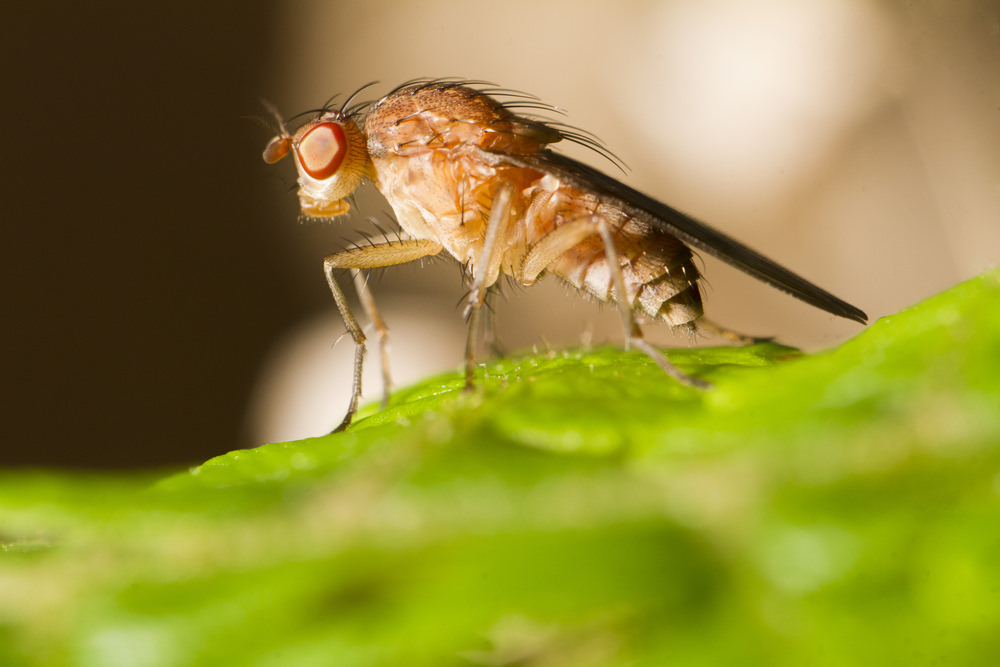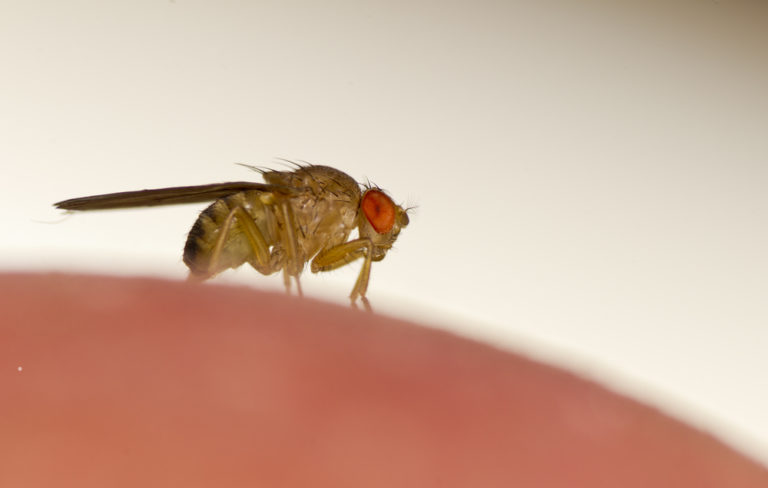Fruit Fly Infestations: Causes and Treatment
Fruit flies are generally a small-time nuisance and pest. You may find them in your hives or around the equipment you use to process honey, particularly around your harvest season and during the canning process.
These flies are attracted to fermentation for subsidence and procreation but are generally very easy to rid yourself of. If left around your honey stores, they can threaten the quality of your honey and may even signify a bigger problem with your hive. You want to prevent the causes of fruit fly infestations and learn to treat for future problems.
Here are some top tips on the causes and treatment of fruit fly infestations:
- They’re most active during the honey flow and harvest season
- Fruit flies may be a sign of a bigger pest problem for your hive, like phorid flies and the small hive beetle
- Deal with an infestation by sanitizing the area and setting vinegar traps
What Is a Fruit Fly?
It’s important to understand the basic facts about fruit flies so that you can deal with them effectively:
- The fruit fly is also known by its scientific name of Drosophila
- This species of insect is quick to breed
- Adults lay 700 to 800 eggs
- Eggs hatch in 24 to 30 hours
- Life span ranges from 7–8 days in summer to 20–30 days during other seasons
- There are 1,500 different species of fruit flies
- Found at sea level to the tops of mountain ranges
How to Identify a Fruit Fly
It may be difficult to conclude, beyond doubt and without a microscope, that your infestation is of fruit flies, but here are the traits to look for:
- ⅛-inch long
- Red or pearly-white eyes
- Tan thorax & head
- Black & grey abdomen
- Feathered antennae
What Causes a Fruit Fly Infestation?
The process of fermentation and its by-products attract fruit flies. During fermentation, yeast acts on sugars, breaking them down and creating alcohol and carbon dioxide. Fruit flies breed in fermenting fruits because they survive on a meal of yeast, breed in an alcohol-rich environment, and develop only in specific temperature ranges.
The key elements in fruit fly growth are:
- Alcohol
- Yeast
- Temperature
Alcohol
The fermentation process produces alcohol. Fruit flies have a resistance and a tolerance to alcohol developed to avoid predation.
Parasitic wasps are the predators of fruit flies. They inject the larva of fruit flies with their larva, which kills the baby fruit flies. Parasitic wasps have an intolerance to alcohol, though. To increase their chances of survival, fruit flies seek out highly fermenting, alcohol-producing, fruit to breed in. Alcohol to the fruit fly signals safety and food.
Yeast
Fruit flies feed off of the microbes found in fermenting fruit, like yeast. They actually have a mutualistic relationship with yeast. They consume it as one of their main sources of food, but they also carry yeast on their feet, which may speed the fermentation process of honey if fruit flies are in the hive.
This creates a feedback loop for the beekeeper that isn’t beneficial. More yeast leads to food for more flies, and more flies may lead to more fermentation.
Temperature
The development of this insect is temperature-dependent. Warmer temperatures speed up the development process, while cooler temperatures will hinder it.
Ideal temperatures for the development of this insect are in the low 80 degrees Fahrenheit. The flies don’t lay eggs at temperatures below 54 degrees Fahrenheit or above 91 degrees Fahrenheit. This helps you know when to be concerned about infestations. While your bees are wintering over the colder months, you don’t need to concern yourself that fruit flies may be laying eggs in your hives.
Unfortunately, the time when the flies are most active is also when your bees will be at their most busy.

Why Are Fruit Flies a Problem for Beekeepers?
Fruit flies are generally classified as nothing more than a pest; they’re certainly not the most sinister of threats to the long-term health of your hive. They’re quick to breed, though, and can become prolific pests.
Fruit Flies May Be a Sign of a Bigger Issue
If you detect fruit flies in your hive or around it, this may be because there’s fermented honey inside. You might actually be surprised to find that fruit flies may be an indication of other problems:
- Small hive beetles
- Decaying fruit
- Phorid flies
Small Hive Beetles
Small hive beetles cause the honey to ferment, which attracts fruit flies. If you see fruit flies, you may want to look for the small hive beetle, as well.
Decaying Fruit
If there’s no fermentation or signs of a fruit fly infestation in your actual hive, the culprit may be decaying fruit from a nearby flowering tree that’s created suitable breeding grounds.
Phorid Flies
Your infestation of fruit flies may actually be an infestation of something far more severe. Phorid flies are often mistaken for fruit flies, especially as they’re so small and hard to identify by the naked eye.
Phorid flies are called “zombie” flies and may be killing your honey bee population. If you notice dead bees in conjunction with an apparent fruit fly infestation, you may need to investigate more.
Fruit Flies Can Contaminate Harvested Honey
Fruit flies will breed in drains, on sticky cloths, on unclean surfaces, and anything else contaminated with honey. While you’re harvesting and processing your honeycomb, sticky liquid may get on everything and anything. When honey sticks to equipment, it creates a hospitable environment for fruit flies. Don’t be surprised if you encounter a fruit fly infestation during harvesting and/or bottling.
You have to be overly cautious about an infestation at this time because fruit flies can carry disease. They tend to also frequent garbage and excrement piles, carrying this waste on their feet, which could seriously contaminate your harvest season and honey crop.
Treatment for Fruit Fly Infestations
If you want to lower your chances for a fruit fly infestation and eradicate any issues that come up, you have to focus on:
- Prevention
- Sanitation
- Traps
Prevention
The most efficient way to reduce your risk of infestation and lower the chances of an insect boom is to think proactively.
Try hanging bundles of herbs or essential oils in an aroma that is distasteful to fruit flies. Fruit flies aren’t the biggest fans of basil, eucalyptus, peppermint, lavender, peppermint, clove, or lemongrass.
Make sure to keep everything as clean as possible. Remember that fruit flies can grow even on the remnants of fruity surfaces and in soil. Make sure to keep your garden clean and the drains, ledges, and clothing that you may touch with honey as clean as possible as well. Taking these precautions will help prevent an infestation.
Some gardeners use mesh bags or covering around plants to keep out fruit flies. This isn’t recommended for beekeepers as the mesh may interfere with the behavior of your hive.
Sanitation
Once you have a problem, the first step in eradicating a fruit fly infestation is removing any potential breeding grounds. If you’re dealing with an infestation around the hive, this entails cleaning out your frames.
When the honey flow comes around, make sure that you’re checking your frames frequently in case they’ve fermented or attracted fruit flies.
When you detect a frame of honey that has fruit fly larvae, you can remove it from the area so that the flies don’t propagate in more frames, thereby preventing population growth. You’ll need to replace that frame to keep the colony active and healthy. If you’ve cultivated a nuc in your beehive practice, you can use the frames from this structure to replace a frame that might have an infestation.
As for any other honey that you may have to harvest too soon, use a water dehumidifier to reduce the water content of the ripening honey and try to salvage the product.
Traps
Once you’ve cleaned out any of the sources of breeding grounds for the fruit flies, deploy a series of traps to kill any that are lingering. Remember that fruit flies have a short life span, so as long as they’re unable to procreate, they should die off. You can use any of the suggested traps, however, to speed the process along:
- Vinegar: Fruit flies are also called “vinegar flies” because of how much they love this substance, making it an effective bait
- Leftover red wine: Use this liquid as a bait to lure fruit flies to a fermented fruit rich in alcohol
- Yeast: The yeast is what really attracts insects that feed on sugar. Be careful, as these traps may attract your bees as well as your fruit flies
- Soap: Adding common dish soap to a liquid-like vinegar or red wine breaks the surface tension of the liquid so that the flies are more likely to drown
- Chemical sprays: Sprays of azinphos methyl, fenthion, trichlorfon, or granular formulations of malathion, endrin, or heptachlor are effective. Remember, substances that attract and harm fruit flies might do the same to your bees. Exercise caution when creating traps
Using any of these liquids in the bottom of a plastic or glass container, you can create traps and hang them from trees outside or place them inside. Make sure to cover the lid of any trap and create holes that are just large enough for fruit flies to enter. Don’t make the holes too large so that your bees go inside and fall victim.
Video: https://www.youtube.com/watch?v=aDBDdLxw0Hw
Using Paints to Improve Trap Effectiveness
You can employ paint to help the efficacy of your traps. You can use bright paint around the entry holes in your trap to attract the flies.
You can also paint a black strip around the top portion of your trap, leading the flies to believe that the unpainted bottom portion is, in fact, the way out of the trap, mimicking the clear sky. The hope for this trick is that the fruit flies fly down, away from the dark paint, and into the bottom of your trap.
Handling Fruit Fly Infestations
A fruit fly infestation may not seem like the worst thing that could happen to your beehive, but if left untreated, it can grow quickly into something bigger. Fruit flies can carry diseases that could contaminate honey. They may also be a sign of a more sinister pest problem in your colony.
If you find yourself with an infestation, thoroughly remove any potential place for them to lay eggs. If you want to try your hand at traps to catch and kill the remaining adults, make sure to exercise caution for your bees. Work to prevent an infestation, and hopefully, you’ll be able to avoid any confrontation with this small insect.

